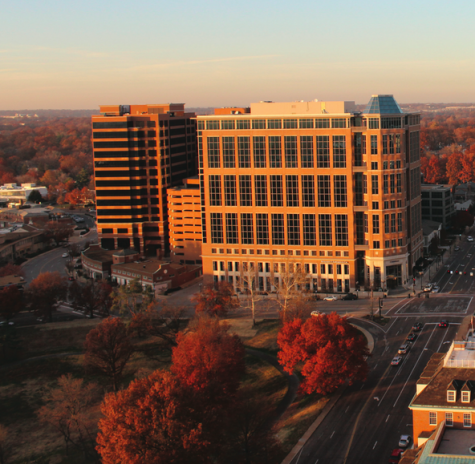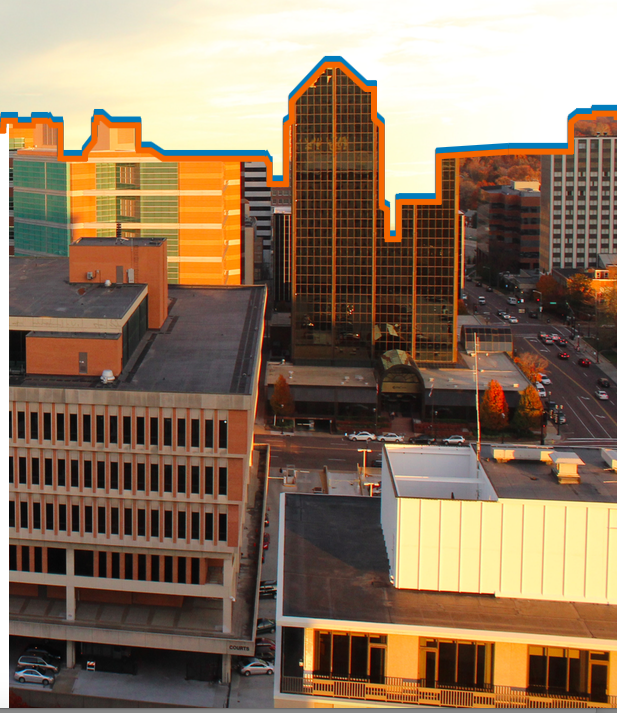Skyline
January 18, 2015
One year ago, the City of Clayton updated its Downtown Master Plan, a long-term project to sustainably develop downtown Clayton. The new plan included a proposal for the Crossing, a 26-story, 70 million dollar residential high-rise building targeted at young professionals.
The City of Clayton houses 16,000 people. During the day, 46,000 peo- ple commute to work in one of Clayton’s 2,000 businesses. The intention of the development is to make downtown Clayton more of a residential city than a commuter destination.
On July 22, the City of Clayton approved a 20-year tax abatement for the residential building, the Crossing. This abatement will decrease the potential property tax revenue that would typically go to the city and, perhaps most controversially, the School District.
Property taxes constitute about 73 percent of the District’s income. And, unfortunately, the education that the Clayton School District can provide is limited by its revenue.
Therefore, this single development in downtown Clayton could have dramatic economic consequences for the city and the District. The question is, what exactly will these consequences be? Will the benefits of economic development outweigh the risk of financial stress on the District?
One thing is certain. For Clayton’s students and residents alike, this is an issue that hits close to home.
I. School System
The Clayton School District’s income is highly dependent upon the value of Clayton properties. In the 2013-2014 school year, $40.5 million of the District’s $55.5 million of public revenue came from property tax- es, according to a statement released by the BOE.
In addition, about half of every property tax bill filed in Clayton goes to funding the school district.
This financial relationship between property tax and District revenue is what gives the District and Clayton residents reason to oppose the suggested development.
According to Clayton resident Dan Phillips, “the abatement puts the funding of the school system at risk.” Phillips is leading the community opposition to the project.
Basically, the District objects to the abatement because it could bring students to the school without providing revenue sufficient to educate those students.
Education is an expensive service. The BOE estimates that it costs about $20,000 to educate each child in the District.
Because about 73 percent of the District revenue comes from property tax, the District needs an increase in this property tax revenue to educate each new child that comes to the District.
In other words, the proposed 300-bedroom development could bring students to the District without providing sufficient property tax to fund their education.
“And at some point, if you attract enough new students and give away enough of the tax revenue, it turns into sort of a negative proposition and an increased cost for the School District,” Clayton Alderman Michelle Harris said. Harris is the sole member of the Board of Alderman that voted against the abatement.
According to Phillips, the property where the development is planned currently brings in about $50,000 in property taxes. The development is predicted to bring in about $300,000 in property tax. Therefore, an additional $250,000 in property tax could educate, at a rate of $20,000 per student, 12 new students to the District.
Phillips believes that adding too many new students without sufficient funding could be economically harmful to the city.
“Even if 19 children move into The Crossing, the city would lose money on the project,” he said. “If 30 children move in, the city would lose 9 million dollars.”
In addition, Phillips feels that the impact extends to students beyond the Clayton borders.
“There are 143 students at your school that don’t live in Clayton,” he said. “They live some place else. But, they’re still able to get the Clayton education. Those children are at risk of losing that benefit. Here, we’re giving all this money to the developer, and we’re putting the school system at risk, and children at risk.”
Longtime Clayton citizen Vivian Eveloff feels that the intentions of the development are undermining why people move to Clayton.
“Few people move to Clayton so they can walk or bike to work,” Eveloff said. “Clayton’s residential appeal is the schools. After families move here, they remain because of the convenience and amenities. Undermining the financial base of Clayton schools is counter-productive for all residents as well as the business.”
Clayton School District Superintendent Dr. Sharmon Wilkinson explained that every decision the city makes has a profound impact on the District.
“Residential development will bring us students we’re responsible for,” she said.
New students are not always a financial drain. Up to a certain point, adding new students to the District is, to use the common analogy, like filling empty seats in an airplane. However, once every seat is full, incremental costs are dramatically higher. The District must hire more staff or increase the number of classes to accommodate the new students. And when the new students are accompanied by a decrease in property tax revenue, the District could be at risk.
Alex Ihnen, the head editor for nextstl.com, strongly endorses the planned development in Clayton. Ihnen believes that the development will benefit the District in the long-term.
“In the end, the school system will receive more than it will cost them,” he said.
Ultimately, the District’s priority transcends the political context of the proposal.
“We have the responsibility to serve and provide a high quality of education that this community expects,” Wilkinson said.
II. Advantages
Despite these risks, there are always concrete advantages to high-rise development. While the opposition is primarily opposed to the idea of a tax abatement, economic development has potential to make a positive impact on any city.
Although the Clayton Board of Education opposes the abatement, Wilkinson admits that “the Board knows that development helps to grow a community.”
Ihnen believes the planned development in Clayton is essential to the growth of the city.
“If Clayton wants more diversity and housing, then it might take an incentive to do that,” Ihnen said.
The Crossing is intended to provide more affordable living options for people who can’t afford the other multi-million dollar condominiums Clayton has to offer.
“The possibility is more diversity, in terms of who lives in Clayton. The apartments won’t be cheap, but more affordable than a lot of other existing options,” Ihnen said.
In addition, despite the tax abatement, the development does promise to provide more property taxes than the property currently provides. According to nextstl.com, the development will yield almost $16 million in property taxes over the first 20 years.
Ihnen believes that The City of Clayton has a firm grasp on the issue.
“If you look at the master plan and the changes they want to make, I think they get it right, and understand some of the challenges pretty well,” he said.
In addition, the development will bring “more people around down- town. Anyone familiar with [Clayton’s] downtown knows it’s empty basically after 5 or 6 PM,” Ihnen said.
According to Ihnen’s article on nextstl.com, “The Crossing would be the first significant new construction apartment project in Clayton
in decades, and as such represents an important first step in diversifying housing options in the city.”
“It comes down to what people want the city to be,” Ihnen said. “I think it’s definitely a good thing for Clayton.”

III. Citizen Perspective
Ihnen believes that the development will benefit the city and the District.
“There are people worried about traffic and their view, things that are very personal to them. These aren’t the types of concern that should stop development,” Ihnen said.
Ihnen insists that most opposition to the development comes from a desire for adherence to tradition.
“There are people that have been here a long time, that don’t want to see it change,” he said.
In addition, this is the first time in which Clayton authorities have approved an abatement for residential development. The city has already instituted tax abatements for commercial properties, including the Centene building and the Cheshire Inn.
“The previous abatement was for Centene and the prospect of jobs. It was not for residential construction and had no effect upon the school system. We don’t agree in using public funds to support private residential construction,” Phillips said.
Another point of contention is that this development will set an unfair precedent for future development projects in and around Clayton.
However, Clayton Mayor Harold Sanger said in an interview with the St. Louis Post-Dispatch that, “This does not set a precedent for any other project. We will look at every project that comes along and evaluate it.”
Ihnen argues that the reality is simple. Clayton needs to change.
The city believes so as well.
“At the end of the day, the mayor and city council want it to happen,”Ihnen said.
When Phillips first heard about the development proposal, he knew that he had to prevent approval.
Accordingly, Phillips led a petition in opposition of the tax abatement. The petition has since gained almost 800 signatures.
“We got twice as many signatures as necessary, and the city said ‘No, we’re not going to accept it,’” Phillips said. “They [the city] are trying to block citizens’ right to vote. The right to vote is basic to democracy. You can’t let someone take away your right to vote, and that’s what the mayor and the city have done,” Phillips said.
The city provided three reasons for not accepting the referendum.
Phillips contends that the city’s objections were illegitimate. “The city gave reasons, which many lawyers have said are incorrect. They should have accepted it,” he said.
Convinced that his basic democratic rights were ignored, Phillips sued the City of Clayton.
“We sued because the mayor would not honor our right to vote,” Phillips said. “The city will now have to go in front of a judge. Hopefully, the judge will agree with us. If so, we will have an election. People will be able to discuss why there should or shouldn’t be an abatement.”
Although they represent different opinions, the reactions of Phillips and Ihnen offer an important reminder: the citizens of Clayton are highly invested in the outcome of this decision.

IV. Conclusion
The proposed tax abatement in downtown Clayton has revealed quite a lot about the city itself.
Phillips’ petition has indicated a high level of engagement between citizens and the government. The District’s objection has exhibited a strong dedication to the educational excellence that defines Clayton’s schools. And the City’s plan has shown a desire to make Clayton the best place it can be.
The solution to the dilemma remains unclear. Perhaps the plan will go forward, or Phillips’ petition will prove successful and the matter will be put to a vote.
Ultimately, however, the solution will involve every side of the controversy. As Dan Phillips said, “We have to settle this as a community.”







![The All-In Coalition marches in the 2022 Homecoming Parade. The students spent the morning decorating the car and threw out frisbees and candy in the parade. ¨[I wanted to] go to the parade [to] get to know everyone better and find common interests besides wanting to combat teen substance abuse,¨ freshman Olivia Lin (pictured left holding the banner) said.](https://www.chsglobe.com/wp-content/uploads/2024/12/image6-1-300x225.jpg)








![Rowing Club teammate Audrey Burger poses next to Juliette Springer at the Haxton Ohio race. The team placed sixth out of 16; in the previous race, they placed fourth. "[After] the race was over, I felt very relieved because of how nervous I was before the race. I also felt proud because I did better then I thought I was going to do," Springer said.](https://www.chsglobe.com/wp-content/uploads/2024/12/IMG_7938-1.jpg)





















